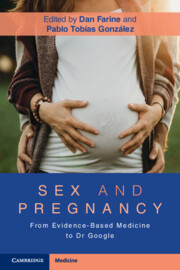Book contents
- Sex and Pregnancy
- Sex and Pregnancy
- Copyright page
- Dedication
- Contents
- Contributors
- Preface
- Section 1 General Issues
- Chapter 1 From Sex for Reproduction to Reproduction without Sex
- Chapter 2 Sex in Pregnancy
- Chapter 3 Physiology of Pregnancy As Related to Sex
- Chapter 4 Does Orgasm Affect Fetal Well-Being?
- Chapter 5 Demographics of Sexual Behavior in Pregnancy
- Chapter 6 Sexual Practices during Pregnancy in Different Cultures
- Chapter 7 What Do Obstetric Guidelines Say?
- Chapter 8 Using the Internet to Educate on Sex and Pregnancy
- Section 2 Specific Issues
- Index
- References
Chapter 6 - Sexual Practices during Pregnancy in Different Cultures
from Section 1 - General Issues
Published online by Cambridge University Press: 09 November 2022
- Sex and Pregnancy
- Sex and Pregnancy
- Copyright page
- Dedication
- Contents
- Contributors
- Preface
- Section 1 General Issues
- Chapter 1 From Sex for Reproduction to Reproduction without Sex
- Chapter 2 Sex in Pregnancy
- Chapter 3 Physiology of Pregnancy As Related to Sex
- Chapter 4 Does Orgasm Affect Fetal Well-Being?
- Chapter 5 Demographics of Sexual Behavior in Pregnancy
- Chapter 6 Sexual Practices during Pregnancy in Different Cultures
- Chapter 7 What Do Obstetric Guidelines Say?
- Chapter 8 Using the Internet to Educate on Sex and Pregnancy
- Section 2 Specific Issues
- Index
- References
Summary
Sexual practices are strongly influenced by social and cultural norms and hence encompass a wide degree of heterogeneity between different cultures. Cultural diversity in sexual practices is subject to an even more complex array of sociocultural, physical, and psychological influences in pregnancy. The literature in this area demonstrates both this diversity and also commonalities among cultures, with universally high rates of female sexual dysfunction (FSD), unnecessary avoidance of sexual activity in pregnancy due to ill-informed fears, and unmet desire for antenatal education and assessment of sexual issues by health practitioners. This chapter presents the current evidence on rates of sexual activity and FSD in pregnancy and influences upon these in different cultures. Increasing awareness of common rates of sexual activity in pregnancy may normalize a reduction in activity and consequently reassure couples that such changes are not necessarily indicative of relationship issues. Conversely, identifying and addressing preventable issues affecting sexual health in pregnancy could potentially improve parental well-being, strengthen family bonds, and positively impact the development of offspring.
Keywords
- Type
- Chapter
- Information
- Sex and PregnancyFrom Evidence-Based Medicine to Dr Google, pp. 32 - 42Publisher: Cambridge University PressPrint publication year: 2022
References
- 1
- Cited by

